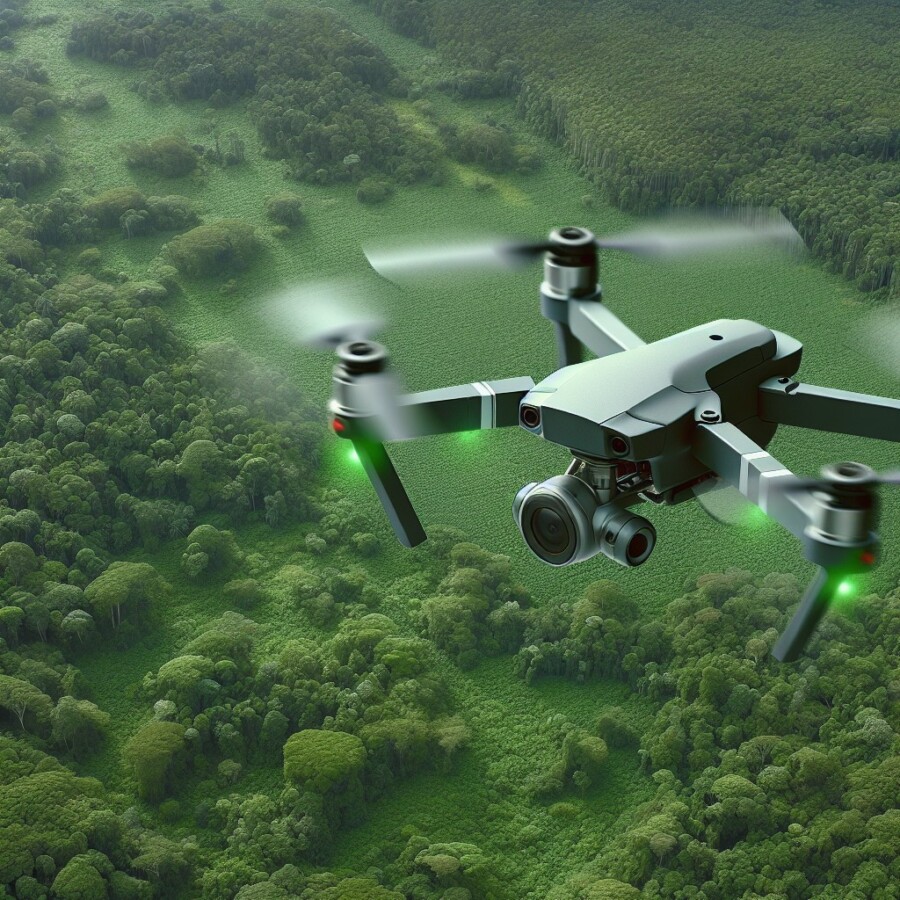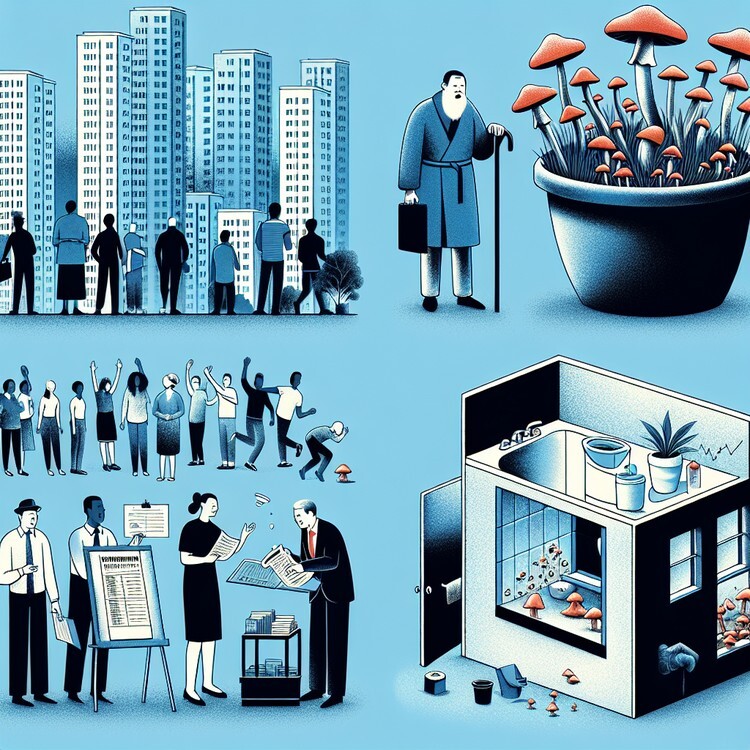The UK government wants flying taxis to be a common sight in the sky by 2028. They have made a plan called the Future of Flight, which says that drones and other flying vehicles will become more autonomous. The plan also says that the first pilotless flying taxi will take off in 2030. But there are some obstacles that need to be dealt with first, like building the right infrastructure and making sure people are okay with the idea.
Flying taxis, also called eVTOLs, are vehicles that look like helicopters and can carry about five people. Right now, they are really expensive and only used by rich people. The government wants to change that and make them more accessible. They also want to let drones fly without someone watching them, which could be useful for things like delivering medicine to remote areas or catching criminals.
The main challenges for flying taxis are infrastructure and what people think about them, according to Craig Roberts, who works at a company called PwC. The government’s plan says that flying from Liverpool to Leeds could take just 26 minutes. But people need to see that flying taxis are convenient and safe. The plan also says that new places for drones to take off and land, called “mini airports,” need to be built.
There have been some small airports for drones in the UK, but more need to be made for flying taxis. The government wants the first vertiport (a special airport for flying vehicles) to be ready this year. They are also thinking about making vertiports at existing airports. They will need to make new rules to support the government’s plan for autonomous air taxis by 2030.
Even though there are challenges, experts think that having flying taxis in the sky by 2028 is possible. The government’s plan, along with help from the industry and new technology, will make it happen.
Original news source: Government wants flying taxis taking off in 2 years (BBC)
🎧 Listen:
Slow
Normal
Fast
📖 Vocabulary:
| 1 | autonomous | Able to operate or work on its own without human control |
| 2 | infrastructure | The basic physical and organizational structures needed for the operation of a society or enterprise |
| 3 | obstacles | Things that block one’s way or prevent or hinder progress |
| 4 | eVTOLs | A type of aircraft that can take off and land vertically and is powered electrically |
| 5 | accessible | Easy to reach or use by everyone |
| 6 | drones | Unmanned aircraft that can fly without a person inside |
| 7 | delivering | The act of taking goods or items to a place |
| 8 | challenges | Difficult situations that need to be dealt with |
| 9 | convenient | Handy and easy to use, making life simpler |
| 10 | vertiport | A special airport designed for vertical takeoff and landing aircraft |
| 11 | existing | Already in place or in use |
| 12 | regulations | Official rules or laws meant to control how something is done |
| 13 | industry | The sector of the economy that manufactures goods or provides services |
| 14 | technology | The application of scientific knowledge for practical purposes, especially in industry |
| 15 | experts | People who have a lot of knowledge about a particular subject because they’ve studied it or have a lot of experience |
Group or Classroom Activities
Warm-up Activities:
– News Summary
Instructions: Divide the class into pairs or small groups. Give each group a few minutes to read the article. Then, ask each group to summarize the main points of the article in a short news summary. They can present their summaries to the rest of the class.
– Opinion Poll
Instructions: Prepare a list of statements related to the article, such as “Flying taxis will become a common sight in the sky by 2028” or “Drones should be allowed to fly without someone watching them.” Have the students walk around the classroom and ask their classmates for their opinions on each statement. They can record their classmates’ responses and then share the results with the class.
– Vocabulary Pictionary
Instructions: Write a list of relevant vocabulary words from the article on the board. Divide the class into teams and give each team a whiteboard or a piece of paper. One student from each team will come to the front of the class and choose a word from the list. They must then draw a picture to represent the word, while their team members try to guess the word. The team that guesses correctly gets a point.
– Pros and Cons
Instructions: Divide the class into two groups. One group will brainstorm the pros of having flying taxis, while the other group will brainstorm the cons. Give each group a few minutes to come up with their ideas. Then, have a class discussion where each group presents their points. Encourage the students to debate and discuss the different perspectives.
– Future Predictions
Instructions: Ask the students to imagine they are living in the year 2030, when pilotless flying taxis are common. In pairs or small groups, have them discuss and make predictions about how their lives would be affected by this technology. They can discuss topics such as transportation, work, leisure, and the environment. After the discussion, ask some groups to share their predictions with the class.
🤔 Comprehension Questions:
1. What is the UK government’s plan called for the future of flight?
2. What are flying taxis also known as?
3. Why does the government want to make flying taxis more accessible?
4. According to Craig Roberts, what are the main challenges for flying taxis?
5. How long does the government’s plan say it could take to fly from Liverpool to Leeds?
6. What are “mini airports” and why do they need to be built?
7. What is a vertiport and where does the government want the first one to be ready?
8. Do experts think it is possible to have flying taxis in the sky by 2028?
Go to answers ⇩
🎧✍️ Listen and Fill in the Gaps:
The UK government wants flying taxis to be a common sight in the sky by 2028. They have made a plan called the Future of Flight, which says that drones and other flying vehicles will become more autonomous. The plan also says that the (1)______ (2)______ flying taxi will take off in 2030. But there are some obstacles that need to be dealt with first, like building the right infrastructure and (3)______ sure (4)______ are okay with the idea.
Flying taxis, also called eVTOLs, are vehicles that look like (5)______ and can carry about five people. Right now, they are really (6)______ and only used by rich people. The government wants to change that and make them more accessible. They also want to let drones fly without someone watching them, which could be useful for things like delivering (7)______ to remote areas or catching criminals.
The main challenges for flying (8)______ are infrastructure and what people think about them, according to Craig (9)______, who works at a company called PwC. The government’s plan says that (10)______ from Liverpool to Leeds could take just 26 (11)______. But people need to see that flying taxis are convenient and safe. The plan also says that new places for drones to take off and land, called “mini (12)______,” need to be built.
There have been some small airports for drones in the UK, but more need to be made for flying taxis. The government wants the first vertiport (a special (13)______ for flying vehicles) to be ready this year. They are also thinking about making vertiports at existing airports. They will need to make new (14)______ to (15)______ the government’s plan for autonomous air taxis by 2030.
Even though there are challenges, experts think that having flying taxis in the sky by 2028 is possible. The government’s plan, along with help from the industry and new (16)______, will make it happen.
Go to answers ⇩
💬 Discussion Questions:
Students can ask a partner these questions, or discuss them as a group.
1. What do you think about the idea of flying taxis?
2. How would you feel if you could ride in a flying taxi?
3. Do you think flying taxis will become a common sight in the sky by 2028? Why or why not?
4. What is an obstacle that needs to be dealt with before flying taxis can become more common?
5. How do you think the government can make flying taxis more accessible to everyone?
6. Do you like the idea of drones flying without someone watching them? Why or why not?
7. How do you think drones could be useful for delivering medicine to remote areas?
8. What challenges do flying taxis face regarding infrastructure?
9. How can the government convince people that flying taxis are convenient and safe?
10. Do you think building “mini airports” for drones to take off and land is a good idea? Why or why not?
11. How do you think the government can make sure that the first vertiport is ready this year?
12. What new rules do you think need to be made to support the government’s plan for autonomous air taxis?
13. Do you think having flying taxis in the sky by 2028 is possible? Why or why not?
14. How do you think the industry and new technology can help make flying taxis a reality?
15. Would you like to ride in a flying taxi? Why or why not?
Individual Activities
📖💭 Vocabulary Meanings:
Match each word to its meaning.
Words:
1. autonomous
2. infrastructure
3. obstacles
4. eVTOLs
5. accessible
6. drones
7. delivering
8. challenges
9. convenient
10. vertiport
11. existing
12. regulations
13. industry
14. technology
15. experts
Meanings:
(A) Things that block one’s way or prevent or hinder progress
(B) Handy and easy to use, making life simpler
(C) The act of taking goods or items to a place
(D) The basic physical and organizational structures needed for the operation of a society or enterprise
(E) Unmanned aircraft that can fly without a person inside
(F) The application of scientific knowledge for practical purposes, especially in industry
(G) People who have a lot of knowledge about a particular subject because they’ve studied it or have a lot of experience
(H) Already in place or in use
(I) Official rules or laws meant to control how something is done
(J) The sector of the economy that manufactures goods or provides services
(K) Able to operate or work on its own without human control
(L) Difficult situations that need to be dealt with
(M) Easy to reach or use by everyone
(N) A special airport designed for vertical takeoff and landing aircraft
(O) A type of aircraft that can take off and land vertically and is powered electrically
Go to answers ⇩
🔡 Multiple Choice Questions:
1. What is the UK government’s plan called?
(a) The Future of Flight
(b) The Flying Taxi Plan
(c) The Autonomous Air Taxi Plan
(d) The Drone and eVTOL Plan
2. What are flying taxis also known as?
(a) eVTOLs
(b) Helicopters
(c) Drones
(d) Autonomous vehicles
3. What is the main challenge for flying taxis?
(a) Cost and accessibility
(b) Infrastructure and public opinion
(c) Safety and convenience
(d) Technology and regulations
4. What could drones be used for in the future?
(a) Catching criminals
(b) Delivering medicine to remote areas
(c) Monitoring traffic
(d) All of the above
5. What is the government’s goal for flying from Liverpool to Leeds?
(a) 1 hour
(b) 2 hours
(c) 26 minutes
(d) 4 hours
6. What are the new places for drones to take off and land called?
(a) Vertiports
(b) Heliports
(c) Droneports
(d) Mini airports
7. What is the government’s plan for autonomous air taxis?
(a) By 2028
(b) By 2025
(c) By 2030
(d) By 2035
8. What do experts think about the possibility of flying taxis by 2028?
(a) It is unlikely
(b) It is uncertain
(c) It is impossible
(d) It is possible
Go to answers ⇩
🕵️ True or False Questions:
1. Building the right infrastructure and gaining public acceptance are obstacles that need to be addressed.
2. The government wants to make flying taxis more accessible to the general public.
3. Currently, flying taxis are expensive and mainly used by wealthy individuals.
4. Flying taxis, also known as eVTOLs, resemble airplanes and can carry around five people.
5. The first piloted flying taxi is expected to take off in 2030.
6. The plan aims to make drones and other flying vehicles less autonomous.
7. The UK government has a plan called the Future of Flight to make flying taxis a rare sight in the sky by 2028.
8. The government’s plan includes the creation of “mini airports” for drones and vertiports for flying vehicles.
Go to answers ⇩
📝 Write a Summary:
Write a summary of this news article in two sentences.
Check your writing now with the best free AI for English writing!
Writing Questions:
Answer the following questions. Write as much as you can for each answer.
Check your answers with our free English writing assistant!
1. What is the UK government’s plan called and what does it aim to achieve?
2. What are flying taxis and who currently uses them?
3. What are the main challenges for flying taxis according to Craig Roberts?
4. What are “mini airports” and why do they need to be built?
5. What do experts think about the possibility of having flying taxis in the sky by 2028?
✅ Answers
🤔✅ Comprehension Question Answers:
1. What is the UK government’s plan called for the future of flight?
The UK government’s plan for the future of flight is called the Future of Flight.
2. What are flying taxis also known as?
Flying taxis are also known as eVTOLs.
3. Why does the government want to make flying taxis more accessible?
The government wants to make flying taxis more accessible to allow more people to use them and not just the rich. They believe it can be a convenient mode of transportation.
4. According to Craig Roberts, what are the main challenges for flying taxis?
According to Craig Roberts, the main challenges for flying taxis are infrastructure and public perception. The government needs to build the right infrastructure and convince people that flying taxis are convenient and safe.
5. How long does the government’s plan say it could take to fly from Liverpool to Leeds?
The government’s plan says that flying from Liverpool to Leeds could take just 26 minutes.
6. What are “mini airports” and why do they need to be built?
“Mini airports” are new places for drones and flying taxis to take off and land. They need to be built to accommodate the increasing number of flying vehicles and provide a safe and organized space for them to operate.
7. What is a vertiport and where does the government want the first one to be ready?
A vertiport is a special airport designed for flying vehicles. The government wants the first vertiport to be ready in the UK.
8. Do experts think it is possible to have flying taxis in the sky by 2028?
Yes, experts believe that it is possible to have flying taxis in the sky by 2028 with the help of the government’s plan, industry support, and advancements in technology.
Go back to questions ⇧
🎧✍️✅ Listen and Fill in the Gaps Answers:
(1) first
(2) pilotless
(3) making
(4) people
(5) helicopters
(6) expensive
(7) medicine
(8) taxis
(9) Roberts
(10) flying
(11) minutes
(12) airports
(13) airport
(14) rules
(15) support
(16) technology
Go back to questions ⇧
📖💭✅ Vocabulary Meanings Answers:
1. autonomous
Answer: (K) Able to operate or work on its own without human control
2. infrastructure
Answer: (D) The basic physical and organizational structures needed for the operation of a society or enterprise
3. obstacles
Answer: (A) Things that block one’s way or prevent or hinder progress
4. eVTOLs
Answer: (O) A type of aircraft that can take off and land vertically and is powered electrically
5. accessible
Answer: (M) Easy to reach or use by everyone
6. drones
Answer: (E) Unmanned aircraft that can fly without a person inside
7. delivering
Answer: (C) The act of taking goods or items to a place
8. challenges
Answer: (L) Difficult situations that need to be dealt with
9. convenient
Answer: (B) Handy and easy to use, making life simpler
10. vertiport
Answer: (N) A special airport designed for vertical takeoff and landing aircraft
11. existing
Answer: (H) Already in place or in use
12. regulations
Answer: (I) Official rules or laws meant to control how something is done
13. industry
Answer: (J) The sector of the economy that manufactures goods or provides services
14. technology
Answer: (F) The application of scientific knowledge for practical purposes, especially in industry
15. experts
Answer: (G) People who have a lot of knowledge about a particular subject because they’ve studied it or have a lot of experience
Go back to questions ⇧
🔡✅ Multiple Choice Answers:
1. What is the UK government’s plan called?
Answer: (a) The Future of Flight
2. What are flying taxis also known as?
Answer: (a) eVTOLs
3. What is the main challenge for flying taxis?
Answer: (b) Infrastructure and public opinion
4. What could drones be used for in the future?
Answer: (b) Delivering medicine to remote areas
5. What is the government’s goal for flying from Liverpool to Leeds?
Answer: (c) 26 minutes
6. What are the new places for drones to take off and land called?
Answer: (d) Mini airports
7. What is the government’s plan for autonomous air taxis?
Answer: (c) By 2030
8. What do experts think about the possibility of flying taxis by 2028?
Answer: (d) It is possible
Go back to questions ⇧
🕵️✅ True or False Answers:
1. Building the right infrastructure and gaining public acceptance are obstacles that need to be addressed. (Answer: True)
2. The government wants to make flying taxis more accessible to the general public. (Answer: True)
3. Currently, flying taxis are expensive and mainly used by wealthy individuals. (Answer: True)
4. Flying taxis, also known as eVTOLs, resemble airplanes and can carry around five people. (Answer: False)
5. The first piloted flying taxi is expected to take off in 2030. (Answer: False)
6. The plan aims to make drones and other flying vehicles less autonomous. (Answer: False)
7. The UK government has a plan called the Future of Flight to make flying taxis a rare sight in the sky by 2028. (Answer: False)
8. The government’s plan includes the creation of “mini airports” for drones and vertiports for flying vehicles. (Answer: True)
Go back to questions ⇧













